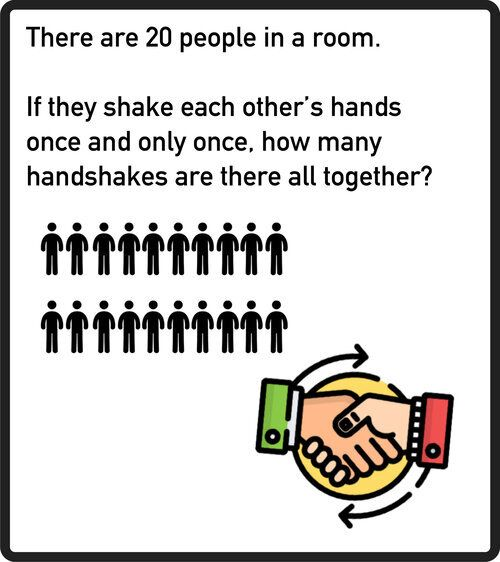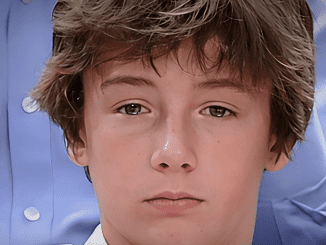Are you ready to challenge your brain and uncover how a seemingly simple question can turn into a deep-thinking exercise? Let’s dive into a timeless logic puzzle about handshakes. It’s a perfect way to test your logical reasoning and attention to detail while having some fun!
The Puzzle That Gets Everyone Thinking
Imagine a room filled with 20 people. Each person shakes hands with every other person exactly once. The question is: How many unique handshakes take place in total?

Sounds straightforward, doesn’t it? But as you’ll soon see, solving this puzzle requires more than just quick math. Before scrolling down for the solution, take a moment to think it through. Grab a pen and paper if needed. Let’s dive deeper into common mistakes, the logical approach, and the foolproof solution.
Common Mistakes and Why They Happen
When solving this puzzle, it’s easy to make assumptions or overlook key details. Here are the three most common mistakes:
1. Misinterpreting the Question
Many people initially think the puzzle is asking how many handshakes one person makes. For instance, they calculate that one person shakes hands with 19 others and incorrectly conclude that the answer is 19. They forget to account for interactions among the other individuals in the room.
2. Double-Counting Handshakes
Another frequent error is counting each handshake twice. For example, if Person A shakes hands with Person B, that’s the same handshake as Person B shaking hands with Person A. Failing to factor in this duplication leads to inflated numbers.
3. Attempting to List Each Handshake
Some try to manually count all the handshakes by listing them one by one. But with 20 people involved, this quickly becomes overwhelming and prone to error. Losing track or miscounting often results in an incorrect total.
How to Solve the Puzzle: A Step-by-Step Guide
To avoid these pitfalls, let’s approach the problem logically and systematically. Here’s how:
Step 1: Understand the Scenario
You’re in a room with 20 people. Each person shakes hands with every other person exactly once. Importantly, no handshake is repeated, and we’re counting the total number of unique handshakes.
Step 2: Visualize the Interactions
Start by picturing Person 1 shaking hands with all the other 19 people. Next, Person 2 shakes hands with everyone except Person 1 (because that handshake is already counted). Similarly, Person 3 shakes hands with everyone except Persons 1 and 2. This pattern continues until the last person, who has no new people left to greet.
Step 3: Apply the Formula
Instead of manually counting handshakes, mathematicians use a simple formula to calculate the total:
Number of Handshakes = n(n – 1) / 2
Here:
- n is the total number of people in the room.
- n – 1 is the number of people each individual shakes hands with (excluding themselves).
- Dividing by 2 ensures that each handshake is counted only once.
Step 4: Do the Math
Let’s calculate the total number of handshakes for n = 20:
- Multiply n by (n – 1):20×19=38020 \times 19 = 38020×19=380
- Divide the result by 2:380÷2=190380 \div 2 = 190380÷2=190
Thus, the total number of unique handshakes is 190.

Why the Formula Works
This formula, n(n – 1) / 2, comes from a branch of mathematics called combinatorics. Specifically, it calculates how many ways you can choose 2 individuals from a group of n, where the order of selection doesn’t matter. Each “choice” corresponds to one unique handshake.
Instead of manually listing every interaction, the formula provides an elegant, efficient, and error-free solution. It’s a beautiful example of how math simplifies complex problems.
Lessons from This Challenge
This handshake puzzle isn’t just a fun brainteaser—it’s also a valuable learning tool. Here are the key takeaways:
- Attention to Detail Matters: Small missteps, like double-counting or misinterpreting the question, can lead to the wrong answer.
- Logical Thinking is Key: Breaking the problem into manageable steps is often the best approach.
- Math Saves Time: Formulas like this one streamline problem-solving and reduce errors.
What About You?
Did you get the correct answer on your first try? What was your thought process? Whether you solved it effortlessly or got tripped up along the way, challenges like this are an excellent way to sharpen your problem-solving skills.
If you enjoyed this puzzle, share it with a friend or family member and see how they approach it. Who knows—you might even inspire a little friendly competition!
Final Thoughts: Keep Your Brain Sharp
Brain teasers like the handshake puzzle aren’t just for fun; they’re a workout for your mind. They challenge your reasoning, test your attention to detail, and improve your ability to think systematically.
So why stop here? Keep exploring puzzles, riddles, and challenges that push your limits. Each one you solve strengthens your brainpower and boosts your confidence in tackling complex problems. Who knows? The skills you develop might just come in handy in unexpected ways.
Next time you’re in a room full of people, think about the handshakes happening around you. It’s more than just a social gesture—it’s a mathematical marvel waiting to be uncovered. Happy puzzling!


